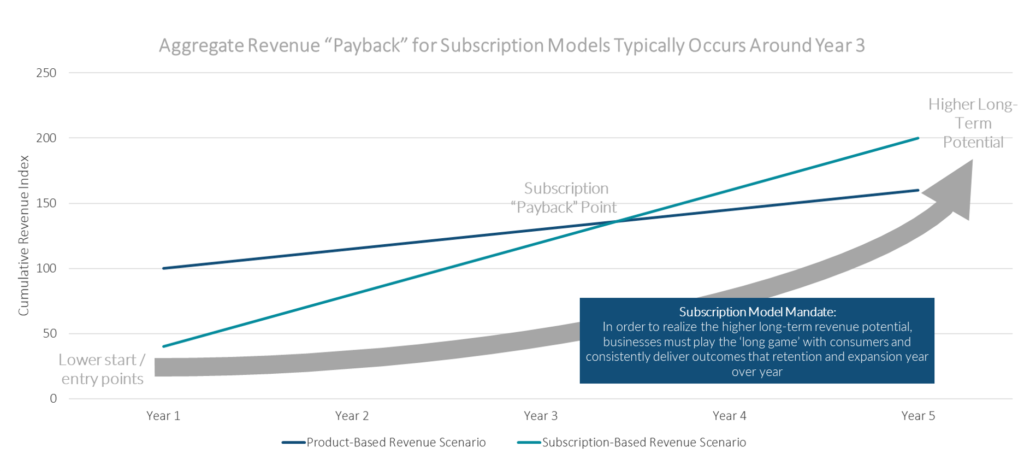Optimizing Marketing Mix in the Subscription Economy
The Market Shift
The subscription economy has impacted all industries and is driving massive changes in business processes and operating models. The dramatic change in customer preferences away from ownership and towards outcomes and increased flexibility has changed the game. Whether companies like it or not, everyone is competing in the subscription business model; regardless of whether they offer subscriptions themselves.
The pandemic only accelerated this transition. According to the Subscribed Institute, in 2020, subscription business revenue growth grew close to 12% compared to the -2% decrease in product/transaction-centric companies. This was true across all verticals, including SaaS, manufacturing, media, business services, and telecommunications, among others.
In order to meet these new customer preferences, businesses must shift from a product-centric transactional model towards a more customer-centric, relationship-based model. While at the surface this may sound simplistic, evaluating how the revenue model changes can illuminate massive implications. Below is an illustrative graph showing the aggregate revenue from a subscription vs. product/transaction model. While every industry has its own unique variants (which manifest in very different pricing and revenue models), the overarching theme is that subscription businesses see an upside when they succeed in the ‘long game’ with consumers – consistently delivering positive experiences through time.
Impact on Marketers and Multi-Channel Activation
As subscription models begin to take hold, the mandate impacts all functions within a business. For marketers, this transition is not trivial. In a traditional product transaction-based model, marketers’ primary objectives focus on pre-purchase activities of brand building and demand generation because the revenue profile is weighted towards this initial transaction.
In the subscription model, marketers must now be pulled further down the customer journey to drive consistent revenue impact. The outcome is that marketers now have more revenue scenarios/objectives to deliver against. What historically had been an acquisition focus, now includes new marketing motions and activities around expansion, engagement, and retention. Again, while every vertical will have different variants of this, the net change is a ‘stretching’ of marketing responsibility across a broader customer journey.
As marketing teams engage in activities with broader objectives than demand gen and acquisition, the complexity of activities grows significantly. An example case below illustrates this change.
For simplicity, let’s start with a single acquisition-focused scenario for a consumer subscription service with a monthly bill rate of ~$20. The marketing mix for this likely includes a large portion of allocation towards digital channels, including social, search, and display along with mobile and app-oriented investments. There is also likely direct marketing, including email, DM, or other types, and most certainly some ‘upper funnel’ brand investments across typical broad reach channels like TV, print, etc.
Now, let’s enhance the scenario with an expansion play to build incremental monthly billings of ~$5 on top of the initial $20. Marketing is the primary driver of conversions for this scenario. Most likely, the marketing mix will need to shift far more towards direct channels, but success also follows from efforts that drive solid subscriber engagement. The upsell is most certainly linked to initial subscription success as well as effective direct ‘demand moment’ marketing.
Finally, compare the complexity of optimizing marketing mix in the ‘acquisition only’ scenario with the ‘acquisition + expansion’ scenario. The first scenario is already complex enough, but now we have multiple objectives. Balancing dollars and tactics across different objectives cannot be solved with a single multi-channel approach. The complexity only grows as more scenarios are added. The solution for marketers lies in the effective use of marketing measurement analytics across the growing complexity.
3 Steps to Optimize Multi-Channel Marketing Mix for Subscription Businesses
- Align measurement and tactics to scenarios across the journey
The first step that marketers must take is to outline each of the critical scenarios marketing supports within the business (awareness/brand, demand gen, sales enablement, expansion, engagement, retention, etc.). With the core scenarios identified, each scenario must have 1-2 core marketing outcome metrics for that scenario. Finally, all marketing campaigns and tactics executed must be aligned to scenarios for effective measurement. If you never tag an email campaign to retention efforts, how will you ever measure the impact relative to your expansion-oriented email campaigns? It is ok to measure the halo of investments in one scenario on those in another, along with tagging multiple objectives to campaigns/tactics, but these must be deliberately chosen. - Develop marketing mix and attribution models for each scenario
With core outcome metrics identified and aligned to marketing scenario tactics, developing the appropriate marketing attribution models is the next step. The goal of these models is to identify the multi-channel impact of all your investments against key objectives to identify the appropriate mix and spend levels to achieve desired outcomes. Depending on the scenario, a handful of options exist including standard marketing mix models (MMM), aggregate multi-touch attribution models (Aggregate MTA), and discrete multi-touch attribution (MTA). - Combine mix optimization with cross-scenario customer lifetime value estimates
With measurement and multi-channel attribution models developed across scenarios, it is possible to begin the process of identifying improvements to the marketing mix. Begin at looking at marketing mix improvements within each scenario. This provides foundational insights into what activities/tactics have the most impact on each of the desired outcomes. Ultimately though, the objective shifts up a level to compare the long-term return of marketing efforts across scenarios. For example, if it is identified that direct mail has a significant impact on retention, that needs to be compared against the value that paid social media marketing has on acquisition. To do this, you must estimate the revenue impact against each of the core marketing outcome metrics. The end result of these efforts is a multi-level marketing optimization solution. This solution allows marketing teams to optimize the revenue outcomes of their efforts across the increasingly complex customer journeys that are now supported.
In Practice – Example Cases
Identifying and Optimizing Retention Drivers at a Global Digital and Print Media Company
Situation:
There’s a global mass media company with a focus on print and digital publications. They were evaluating the impact of marketing for one of its largest titles on acquisition and renewals to identify key insights, tactical adjustments, and optimize marketing budgets. The company lacked sufficient insight into the multi-channel halo effects of various marketing stimuli on new subscribers, as well as working across multiple objectives (acquisition vs. retention).
Measurement Approach:
The first step the company took was to separate the tactics deployed against two different response metrics/KPIs, namely new subscribers and renewed subscribers. Following this, a custom aggregate MTA was developed for each of the scenarios.
Outcome:
The company found that while their retention marketing was a significant driver of renewals, greater than 60% of the contribution came from subscriber engagement, which had a number of different marketing influence points. Newsletters and amplification of key external events were identified as significant drivers of renewal rates and extremely efficient. The company was then able to devise a more deliberate engagement strategy with marketing support that extended to activities between new user acquisition and renewal marketing.
Holistic Measurement of Upper Funnel Investment for Subscription Media Company
Situation:
A large subscription media company was evaluating the impact of its upper-funnel brand marketing investments on subscriber acquisition and conversion. The company had traditionally focused its marketing on digital and direct marketing channels, with limited investments in more mass media. Given this transition, it had become extremely important to understand if these large investments were moving the needle on subscriber growth.
Approach:
The core hypothesis was that brand investments would have the most impact on subscriber acquisition rather than retention or conversion of lapsed subscribers, but it was important to evaluate across the variety of conversion types. Four separate response measures were utilized that mapped to the various stages of acquisition and lapsed conversions. Separate marketing mix models (MMM) were constructed for each of the four stages to understand the differential impact of various marketing efforts against each of those, with the upper funnel brand investments acting as a ‘halo’ across all four models.
Outcome:
The results of the analysis painted an interesting picture of the impact of brand efforts on subscriber growth. While the upper funnel investments were found to have an impact on new conversions, the largest impact was identified on the lapsed customers. The net result was that when looking across the various response areas, brand advertising was close to as efficient as the other forms of direct and digital marketing, supporting the case for continuing to grow the marketing mix across both brand and demand gen efforts.
A simplified approach to multichannel halo analysis
With over 25 years of supporting clients in improving their marketing methods and strategies, we’ve identified a simplified approach to halo analysis—helping to measure the direct and indirect attribution of tactics in a multichannel marketing strategy.






